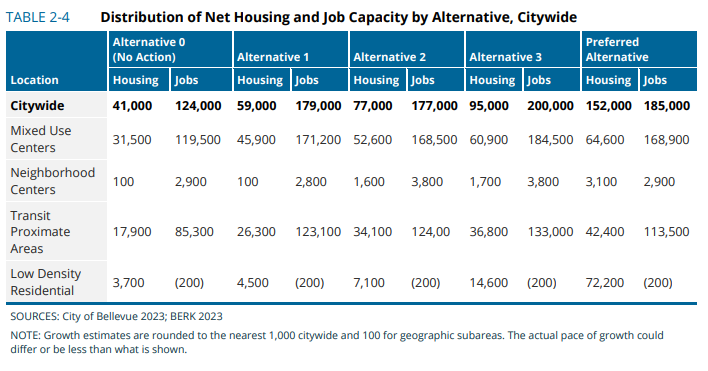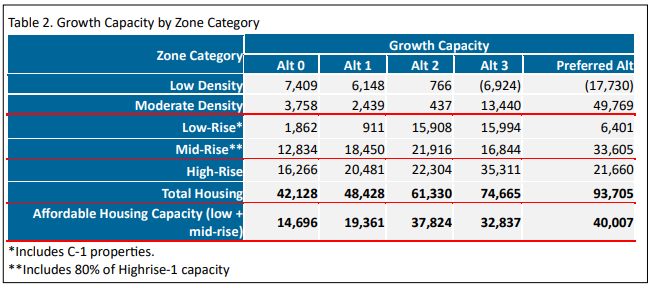Edit: see added parentheticals below about Table 2 and cottage maximum size.
According to the Comprehensive Plan, “Bellevue is planning for sufficient capacity to accommodate the 35,000 units projected to be built by 2044.” There were also various growth levels analyzed as part of the Final Environmental Impact Statement (FEIS) for the Comprehensive Plan. Note: Bellevue had 63,200 housing units in 2019.
FEIS page 69: “The Preferred Alternative has capacity for about 216,000 housing units, about 152,000 additional capacity for housing units over 2019 housing units and about 111,000 over the capacity under the No Action Alternative. About 47 percent of the additional capacity (and about 61 percent of the capacity over the No Action Alternative) is in low-density residential areas, primarily due to the additional capacity created under HB 1110 and HB 1337.”
The additional density under HB1110/1337 can be compared with the density added in Bellevue’s proposal. First, adding 3 units to most of the ~30,000 “single family” properties results in potential growth of 72,200 units in Low Density Residential areas (see Table 2-4). It is clear that this is not simply 30,000 x 3, so perhaps it takes into account the fact that some areas have covenants or environmentally critical areas, and I think the assumption is that a little more than half of the single family houses become teardowns (Table 2). If we add four more units beyond that with ADUs and a fee-in-lieu option, there would be perhaps an additional 66,300* housing units beyond what was studied under the FEIS, for a total of 138,500 new units in low density areas and 218,300 new units citywide.

If even 5,000 single family homes are converted to middle housing, that could mean an increase of 35,000 housing units, reaching our housing target even if there were no new apartment buildings in the growth centers and neighborhood centers. On page 1255 of the Comprehensive Plan FEIS, we see that the growth capacity shown on Table 2 for Low Density areas is expected to be *negative* 17,730 units under the preferred alternative (it has been clarified that this is due to the reclassification of R-2.5 through R-7.5 into the Moderate Density bucket, rather than predictions about demolition). I still expect that 5,000 teardowns over the next 20 years is a significant underestimate, and there will be greater pressure to tear down a home if you can put eight units on the lot than if you could put four on that lot.

I do assume that the “yield” of the fourth, fifth, sixth, and seventh additional units Bellevue is potentially going to provide will be lower than the first three additional units; some developments will be built with only four or only six units on the site when the fee-in-lieu costs don’t pencil out. Counterbalancing that is the extra density from adding co-living (easily 24 sleeping units on a lot) to large areas close to growth centers and adding three-bedroom “cottage” subdivisions (22+ units per acre)(with a lower maximum size as of the June 10th meeting, this is now 26+ cottages/acre) to the areas far from growth centers. Neither of these was included in the FEIS scenarios.
Note: According to the 2025 State Legislative update presented to City Council on March 18, 2025, we currently have over 12,000 housing units in the development pipeline. You can see many of these in the Building Bellevue Major Projects map.
Growth in the mixed use centers, neighborhood centers, and transit proximate areas may also be higher than forecast in the Comprehensive Plan FEIS. The city’s HOMA LUCA adds density in neighborhood centers and growth centers, HB 1998 Co-living will allow greater density in mixed use areas and areas with six units “by right” (Bellevue is poised to expand affected areas by increasing the middle housing density beyond the state requirement), and HB 1491 will add TOD density around major transit. “Major Transit” will also affect more of Bellevue than it does now (RapidRide K), and it is unclear if that was included in the FEIS estimate, since the RapidRide K route was undetermined at the time that was written.
The range of potential outcomes we are facing is far too wide to reasonably expect us to plan for. If we keep to the 35,000 target, that represents about 25% growth for each of the next two decades. Given the timeline associated with adding schools and other major amenities, even 25% is aggressive and ambitious. We won’t have the money to build those schools without knowing with certainty that those new residents are coming, and yet we have a responsibility to be prepared to accommodate the growth promises we’re making now via the middle housing LUCA.
On the flip side, we may be opening the floodgates, but it won’t matter if no rain is falling upriver. It’s certainly possible that we won’t meet our targets and will fail to provide the housing that our community considers to be a necessity, if there are not population in-flows to Washington as a whole and the interest rates builders pay continues to be high. It is very important for Council to consider strategies to narrow the range of plausible outcomes we need to plan for, ensuring that we have the healthy growth we want, and also that we don’t get swept away if the water does start to rise.
* 49,769 x 4/3 = 66,358.7
Leave a Reply